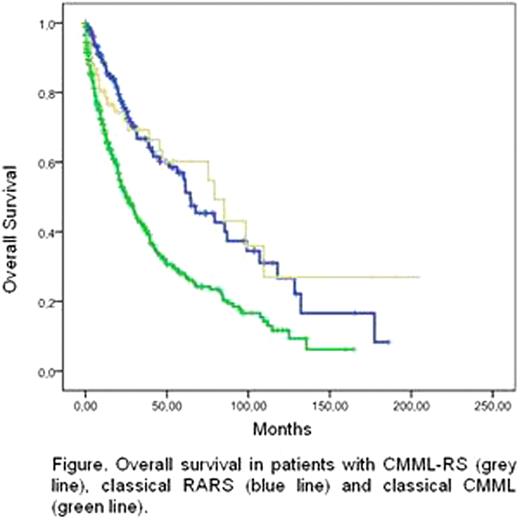Abstract
Abstract 290
The main diagnostic criteria for chronic myelomonocytic leukemia (CMML), a heterogeneous disorder sharing features of myelodysplastic syndromes (MDS) and chronic myeloproliferative disorders, is the existence of a sustained absolute monocyte count in peripheral blood (PB) above 1 × 109/L. On the other hand, the presence of more than 15% ring sideroblasts (RS) in bone marrow (BM) is a well recognized morphological feature of dyserithropoiesis and, in the absence of blasts in PB and less than 5% blasts in BM, is diagnostic of refractory anemia with ring sideroblasts (RARS) with or without multilineage dysplasia. In FAB as well as in WHO classification systems for myeloid neoplasms those cases presenting with both an absolute monocyte count in PB above 1 × 109/L and more than 15% RS in BM are diagnosed of CMML but the preeminence given to the monocyte count in PB over the proportion of RS in BM is not evidence-based. The main purpose of this study was to assess the clinical and biological characteristics and outcome [overall survival (OS) and acute leukemic (AL) evolution] of a series of 77 patients diagnosed of CMML by FAB and WHO criteria who had more than 15% RS in BM at presentation (CMML-RS) and to compare them with those of a series of 417 patients with CMML with less than 15% RS (classical CMML) and those of a series of 178 patients with classical RARS (38 patients with and 140 patients without multilineage dysplasia). Comparisons of proportions and ranks of variables between different groups were performed by chi square or Mann-Whitney-U tests as appropriate. Actuarial curves of OS and risk of AL evolution were built by Kaplan-Meier method and differences between curves compared with log-rank tests. Multivariate analyses of OS and risk of AL evolution were performed by Cox proportional hazards regression method. Patients with CMML-RS had lower hemoglobin level (P=0.008), lower absolute counts of leukocytes (P<0.001), neutrophils (P=0.002), and monocytes (P<0.001), higher platelet count (P<0.001), lower proportion of blasts in PB (P=0.015) and BM (P=0.035), and higher serum level of ferritin (P<0.001) and LDH (P=0.06) than patients with classical CMML. Patients with CMML-RS had significantly better OS than patients with classical CMML (median, 79 mo and 26 mo respectively; P<0.001; Figure) as well as lower risk of AL evolution (cumulative proportion at 5 yr, 7% and 20% respectively; P=0.07). Further, the beneficial prognostic relevance of the proportion of RS in BM on OS was maintained in multivariate analyses (P<0.001). In marked contrast, OS (median, 64 mo; Figure) and risk of AL evolution (cumulative proportion at 5 yr, 9%) of patients with classical RARS were closely similar to those observed in patients with CMML-RS (P>0.90). Patients with classical RARS were more anemic (P=0.001), had lower absolute counts of leukocytes (P<0.001), neutrophils (P=0.01), and monocytes (P<0.001), higher platelet count (P=0.002), lower proportion of blasts in PB (P=0.01) and BM (P<0.001), and lower serum level of ferritin (P=0.01) and LDH (P=0.11) than patients with CMML-RS. To avoid the potential interference in the analyses of disparities in the proportion of blasts in BM in the different groups of patients all the analyses were repeated excluding from all the groups those cases with 5% or more blasts in BM. Fifty-three patients with CMML-RS, 245 with classical CMML, and all 178 with classical RARS were evaluable for these sub-analyses. The results obtained were similar to those in the overall series of patients (data not showed). To sum up, all these results show that the proportion of RS in BM is a much powerful prognostic indicator than absolute monocyte count in PB in CMML and demonstrate that the presence of a proportion of RS greater than 15% in BM in patients with CMML defines a subset of patients that clearly differ in their biological characteristics from classical CMML and classical RARS. CMML-RS has a clinical course very close to that of classical RARS and markedly better than classical CMML. These data strongly suggest that CMML-RS is an overlapping syndrome between CMML and RARS. For clinical purposes patients with >1 × 109 monocytes/L in PB and >15% RS in BM should be better classified as RARS than as CMML. The WHO classification needs to be revisited to account for those findings.
No relevant conflicts of interest to declare.
Author notes
Asterisk with author names denotes non-ASH members.


This feature is available to Subscribers Only
Sign In or Create an Account Close Modal